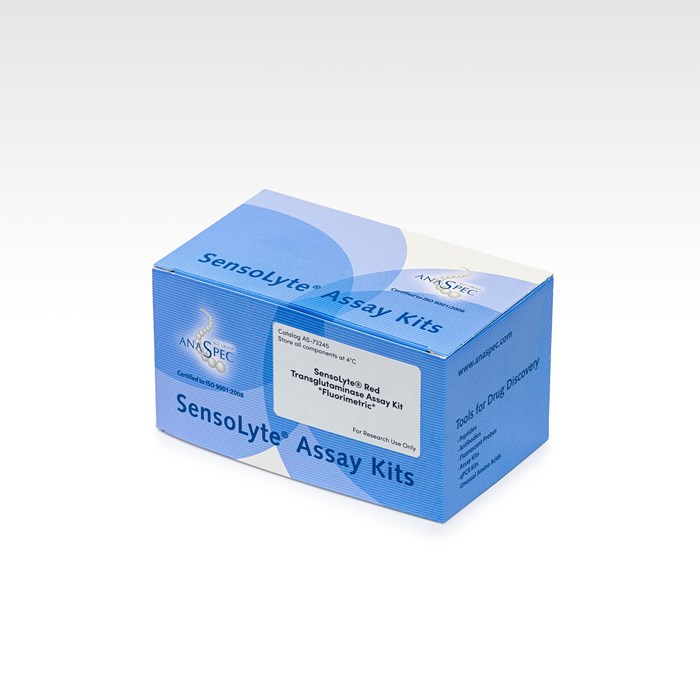We use cookies to offer you the best experience on our site. You can find out more about the cookies we use or disable them in the Cookie settings
SensoLyte® Red Transglutaminase Assay Kit Fluorimetric - 1 kit
- Cat.Number : AS-72245
- Manufacturer Ref. :
-
Availability :
In production
- Shipping conditions : Ice delivery fees must be applied
Alternative choices
Transglutaminases (TGs) are Ca2+ and thiol-dependent enzymes that catalyze posttranslational modifications of proteins. These covalent reactions include formation of isopeptide linkages between the carboxamide groups of protein-bound glutamine residues and ε-amino groups of protein-bound lysine and polyamine residues, hydrolysis and esterification of glutamine residues.1 Family of TGs includes at least nine members: TG 1-7, coagulation factor XIIIa, and the keratinocyte membrane bound TG form. TG has attracted considerable interest as a potential drug target. Its activity is thought to contribute to Alzheimer disease, Parkinson disease, Huntington disease, and supranuclear palsy.
SensoLyte® Transglutaminase Activity Assay Kit provides a convenient assay for the high throughput screening of TG modulators and inhibitors. TG catalyzes covalent bond formation between a free amine group of poly-D-lysine, which is coated on the plate surface, and ?-carboxamide group of glutamine in biotin-TVQQEL peptide substrate. The reaction immobilizes biotin-conjugated peptide to the plate surface. The amount of immobilized biotin is determined using streptavidin-horseradish peroxidase (HRP), 10-Acetyl-3,7-dihydroxyphenoxazine (ADHP), and hydrogen peroxide (H2O2). The non-fluorescent ADHP is oxidized to the strong fluorescent resorufin in the presence of H2O2 by peroxidases, such as HRP. The fluorescence intensity of resorufin is proportional to the activity of TG in a sample. Assay is performed in a convenient 96-well microplate format.
Specifications
| Packaging | |
| Kits components |
|
|---|---|
| Chemistry | |
| UniProt number |
|
| Properties | |
| Absorbance (nm) |
|
| Emission (nm) |
|
| Storage & stability | |
| Storage Conditions |
|
| Activity | |
| Application | |
| Biomarker Target | |
| Detection Method | |
| Detection Limit |
|
| Research Area | |
| Sub-category Research Area | |
| Usage |
|
| Codes | |
| Code Nacres |
|
Downloads
You may also be interested in the following product(s)


SensoLyte® 520 BACE2 Activity Assay Kit Fluorimetric - 1 kit

